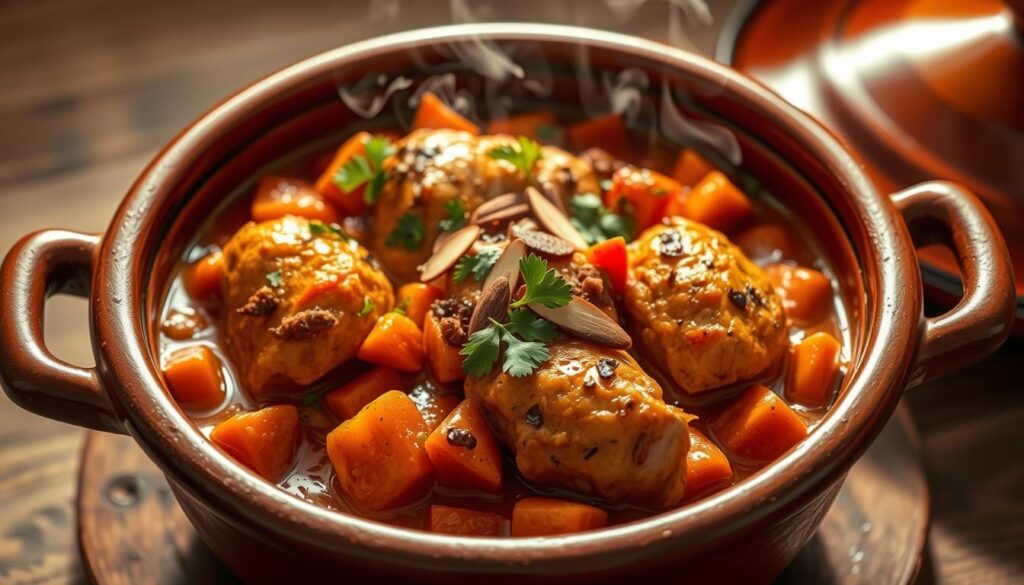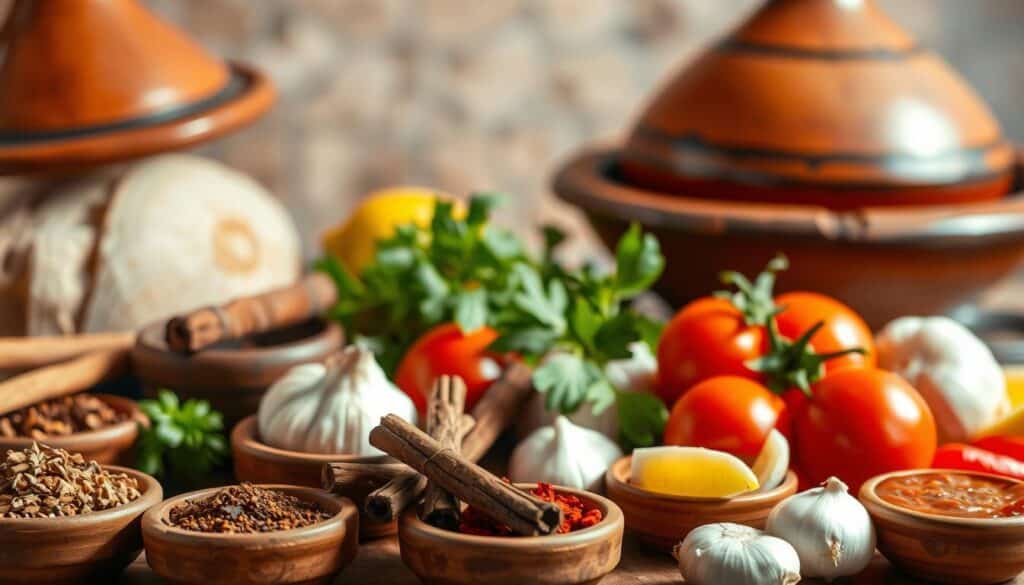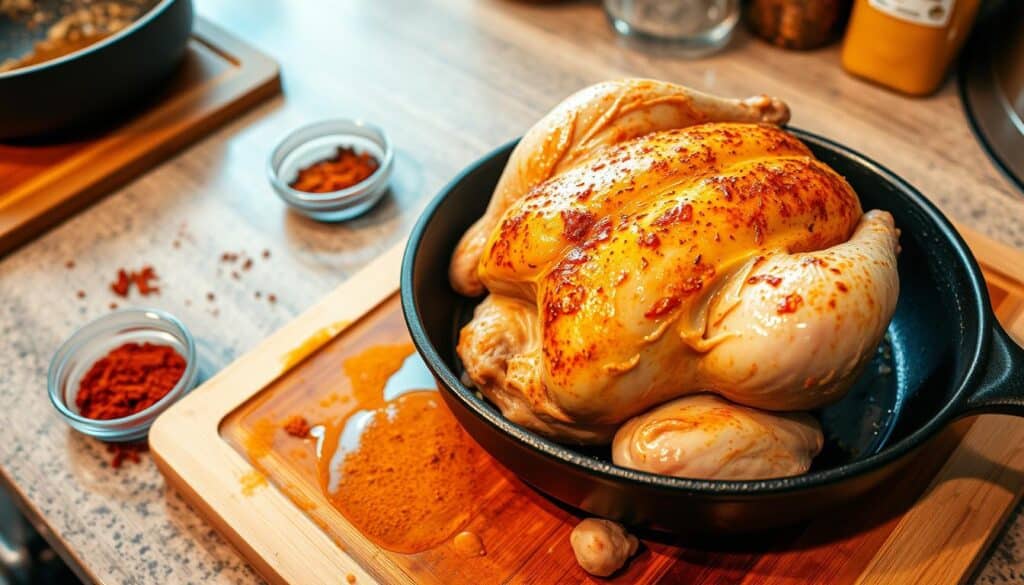There’s something magical about North African cuisine. The rich aromas, vibrant spices, and hearty dishes always transport me to a place of warmth and comfort. My journey with this cuisine began years ago, and it’s been a love affair ever since. One dish that stands out is the Tajine Chicken—a flavorful, slow-cooked meal that’s as comforting as it is delicious.
Thank you for reading this post, don't forget to subscribe!What I love most about this dish is its simplicity. You don’t need an authentic clay tagine to make it. A cast-iron braiser or Dutch oven works just as well. The key ingredients—like tender chicken thighs, tangy preserved lemons, and a blend of spices—create a sauce that’s rich and deeply satisfying. It’s a dish that feels special yet is surprisingly easy to prepare.

This recipe is a blend of traditional methods and modern shortcuts. It’s perfect for a cozy weeknight dinner or a weekend gathering. Pair it with couscous or crusty bread, and you’ve got a meal that’s sure to impress. Trust me, once you try it, you’ll understand why this dish holds a special place in my heart.
Key Takeaways
- North African cuisine is known for its rich flavors and comforting dishes.
- You don’t need an authentic tagine to make this dish—a Dutch oven works perfectly.
- Key ingredients include chicken thighs, preserved lemons, and a blend of spices.
- This recipe combines traditional methods with modern convenience.
- It pairs wonderfully with couscous or crusty bread for a complete meal.
Ingredients and Essential Equipment
The secret to a flavorful North African dish lies in its ingredients and tools. Whether you’re a seasoned cook or a beginner, having the right components and equipment ensures a smooth cooking process and a delicious result.
Key Ingredients and Spices
Start with fresh, high-quality ingredients to bring out the best flavors. Here’s what you’ll need:
- Protein: Bone-in, skin-on thighs are ideal for their rich flavor and tender texture.
- Fresh Produce: Onion, garlic, and cilantro add depth and aroma to the dish.
- Spices: A blend of cumin, ginger, turmeric, and paprika creates the signature North African taste.
- Flavor Enhancers: Preserved lemon and green olives add a tangy, briny kick.
- Pantry Staples: Olive oil, salt, and pepper are essential for seasoning and cooking.

Required Kitchen Tools and Vessels
While a traditional tagine is ideal, you can use accessible alternatives. Here’s what works best:
- Cookware: A cast-iron Dutch oven or heavy skillet distributes heat evenly for perfect results.
- Utensils: A sharp knife, cutting board, and wooden spoon are must-haves for prep and cooking.
- Measuring Tools: Use measuring spoons and cups for precise spice and ingredient portions.
- Thermometer: Ensure your dish is cooked to perfection with a meat thermometer.
For more tips on achieving crispy skin and tender meat, check out this braised chicken recipe.
Step-by-Step Cooking Process
Every step in this recipe builds layers of flavor that come together beautifully. From searing to simmering, each phase is designed to create a dish that’s rich, tender, and deeply satisfying. Let’s dive into the process.
Browning the Chicken
Start by heating a tablespoon of olive oil in a heavy skillet or Dutch oven over medium heat. Pat the chicken thighs dry with a paper towel and season them generously with salt and pepper. Place them skin-side down in the pan and let them cook undisturbed for about 5 minutes, or until the skin is golden and crispy. Flip and cook for another 4 minutes. Remove the pieces and set them aside.

Cooking the Aromatics and Forming the Sauce
In the same pan, add thinly sliced onion and cook until softened, about 5-7 minutes. Stir in minced garlic and a blend of spices like cumin, ginger, and turmeric. Cook for 30 seconds until fragrant. Sprinkle in a tablespoon of flour to thicken the sauce, then pour in chicken broth and a drizzle of honey. Scrape up the browned bits from the pan to add depth to the sauce.
Simmering and Final Adjustments
Return the chicken to the pan, nestling it into the sauce. Add sliced carrots and a handful of green olives for texture and flavor. Cover and let it simmer on low heat for about 20 minutes, or until the chicken is fully cooked and tender. Taste the sauce and adjust the seasoning with more salt, pepper, or a squeeze of lemon juice if needed. For a tangy twist, add a few slices of preserved lemon.
This dish pairs wonderfully with Moroccan-style couscous or crusty bread to soak up the flavorful sauce. Enjoy every bite of this comforting meal!
Mastering Your tajine chicken recipe
Perfecting a traditional dish requires patience and attention to detail. Over the years, I’ve learned a few tricks to elevate this meal to its full potential. Here’s how you can refine your technique and gain confidence in the kitchen.
Start by achieving the ideal sear on your thighs. Pat them dry before placing them in a hot pan with a drizzle of olive oil. This step locks in moisture and creates a golden crust. Avoid overcrowding the pan to ensure even browning.
Next, focus on the sauce. Sauté onion and garlic until fragrant, then add your spice blend. Let the spices bloom for 30 seconds to release their full aroma. Deglaze the pan with broth, scraping up the flavorful bits stuck to the bottom.
Here are a few tips to avoid common pitfalls:
- Don’t rush the simmering process. Low and slow ensures tender meat and concentrated flavors.
- Balance tanginess with a squeeze of lemon or slices of preserved lemon.
- Experiment with garnishes like fresh herbs or toasted nuts for a professional finish.
Remember, practice makes perfect. Adapt the recipe to suit your taste preferences and enjoy the journey of mastering this comforting dish.
Tips for Enhancing Flavor: Spices, Olives, and More
The beauty of North African cooking lies in its ability to transform simple ingredients into something extraordinary. By tweaking spices, olives, and preserved lemon, you can create a dish that’s uniquely yours. Here’s how to make it your own.
Customizing Your Spice Blend
Spices are the soul of this dish. Start with a base of cumin, ginger, turmeric, and paprika. Adjust the amounts to suit your taste. For a smoky flavor, add more paprika. For warmth, increase the ginger. Here’s a quick guide to help you experiment:
| Spice | Flavor Profile | Suggested Amount |
|---|---|---|
| Cumin | Earthy, nutty | 1/2 tsp |
| Ginger | Warm, spicy | 1/2 tsp |
| Turmeric | Earthy, slightly bitter | 1 tsp |
| Paprika | Sweet, smoky | 1.5 tsp |
Don’t be afraid to taste as you go. A pinch of saffron or a dash of cinnamon can add depth without overpowering the dish.
Incorporating Olives and Preserved Lemon
Olives and preserved lemon bring a tangy, briny flavor that’s hard to beat. Green olives are classic, but kalamata olives add a richer, fruitier note. For the lemon, preserved rinds offer a unique umami flavor. If you don’t have them, fresh lemon zest and juice work well too.
- Add olives halfway through cooking to retain their texture.
- Use preserved lemon sparingly—it’s potent but delicious.
- Balance tartness with a drizzle of honey or a handful of raisins.
Finally, don’t forget fresh herbs. A sprinkle of cilantro or parsley just before serving adds brightness and ties everything together.
Serving Suggestions and Ideal Pairings
The perfect meal isn’t just about the main dish—it’s about the complete experience. When serving a flavorful dish like this, the sides and presentation play a huge role in creating a memorable dining experience. Here’s how to make your meal shine.
Couscous, Bread, and Other Sides
Traditional pairings like couscous and Moroccan bread (khobz) are classic choices. They soak up the rich sauce beautifully. For a fresh twist, try adding a vibrant vegetable salad or roasted seasonal veggies like carrots and fennel.
If you’re feeling adventurous, unconventional sides like French fries or mashed potatoes can add a fun twist. Here’s a quick guide to pairing options:
| Side | Flavor Profile | Best For |
|---|---|---|
| Couscous | Neutral, fluffy | Traditional pairing |
| Khobz | Chewy, hearty | Soaking up sauce |
| Vegetable Salad | Fresh, tangy | Balancing richness |
| French Fries | Crispy, salty | Unconventional twist |
Plating and Garnishing Ideas
Presentation matters. Keep it rustic yet elegant by serving the dish in a shallow bowl or on a large platter. Nestle the chicken pieces in the center and surround them with sides like couscous or roasted veggies.
Garnish with fresh herbs like cilantro or parsley for a pop of color. A sprinkle of toasted nuts or a drizzle of olive oil can add texture and depth. Here are a few tips for Instagram-worthy plating:
- Use contrasting colors—bright greens, reds, and yellows.
- Arrange ingredients in a way that feels natural and inviting.
- Add a final touch of lemon zest or a few olives for visual appeal.
Remember, the goal is to create a meal that’s as beautiful as it is delicious. With these tips, you’ll impress your guests and enjoy every bite.
Make-Ahead and Storage Ideas
Meal prep can be a game-changer for busy weeknights, and this dish is no exception. With a little planning, you can enjoy a flavorful meal without the last-minute rush. Here’s how to make it ahead and store it properly.
Preparing in Advance
To save time, prepare the dish up to a day ahead. Cook it as usual, then let it cool completely. Store it in an airtight container in the refrigerator for up to two days. This allows the flavors to meld, making it even more delicious.
If you’re using preserved lemon or olives, add them just before reheating to maintain their texture. This small step ensures every bite is as fresh as the first.
Reheating and Freezing Tips
When reheating, use a pot on the stovetop over low heat. Add a splash of broth or water to keep the sauce from drying out. Stir occasionally to ensure even heating. This method preserves the dish’s rich flavors and tender texture.
For freezing, portion the dish into airtight containers or freezer bags. Label them with the date and use within three months. Thaw it overnight in the refrigerator before reheating. This makes it a convenient option for quick meals.
Here are a few tips to maintain quality:
- Cool the dish completely before storing to prevent condensation.
- Use glass containers for reheating to avoid plastic odors.
- Reheat only what you’ll eat to avoid multiple temperature changes.
This traditional Moroccan dish is perfect for meal prep. With these tips, you’ll always have a delicious meal ready to enjoy.
Conclusion
Bringing North African flavors into your kitchen has never been easier. This dish combines simple ingredients like onion, spices, and olive oil to create a meal that’s both comforting and rich in tradition. Whether you’re cooking for a weeknight dinner or a special gathering, the process is straightforward and rewarding.
Feel free to experiment with substitutions—swap couscous for rice or add extra veggies for a personal touch. The blend of spices and the tang of lemon make this recipe versatile and deeply satisfying.
Mastering this tagine has enriched my cooking repertoire, and I hope it does the same for you. Give it a try and share your experience in the comments below. I’d love to hear how it turned out!
FAQ
What’s the best way to brown the chicken for a tagine?
I always heat olive oil in a pan over medium heat, then sear the chicken pieces until golden brown on all sides. This step locks in flavor and creates a rich base for the dish.
Can I use boneless chicken thighs instead of bone-in pieces?
Absolutely! Boneless thighs work well and cook faster. Just adjust the cooking time to avoid overcooking.
What spices are essential for an authentic Moroccan flavor?
I rely on cumin, ginger, turmeric, and a pinch of cinnamon. These spices create that warm, aromatic profile characteristic of North African cuisine.
How do I incorporate preserved lemon into the dish?
I chop the preserved lemon into small pieces and add it during the simmering process. Its tangy, salty flavor elevates the entire dish.
Can I make this ahead of time?
Yes! In fact, the flavors deepen if you prepare it a day in advance. Just reheat gently before serving.
What sides pair best with a chicken tagine?
I love serving it with fluffy couscous or warm crusty bread. A side of green olives and a sprinkle of fresh cilantro add the perfect finishing touch.
How do I store and reheat leftovers?
Store it in an airtight container in the fridge for up to 3 days. Reheat on the stovetop over low heat, adding a splash of water if needed.
Can I freeze this dish?
Definitely! Freeze it in portions for up to 3 months. Thaw overnight in the fridge and reheat gently to preserve the texture.
There are no reviews yet. Be the first one to write one.

